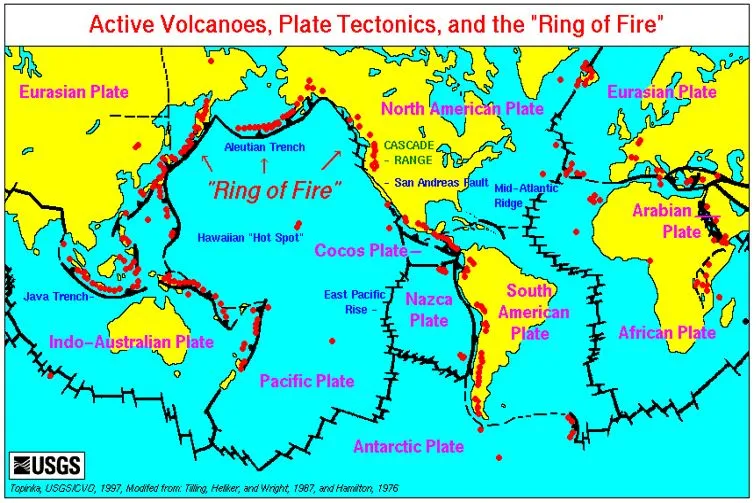

5th June 2025 (11 Topics)
Mains Issues
Context
On June 2025, Mount Etna in Italy erupted, producing an enormous ash and gas column visible several kilometres into the sky. While visually dramatic, the eruption caused no injuries or significant disruption, prompting global scientific interest in its eruptive behaviour and geological implications.
Mount Etna Eruption: Understanding the Dynamics of Active Volcanism in Europe
Mount Etna
Geographic Location and Characteristics
- Located on the eastern coast of Sicily, Italy.
- Type: Active stratovolcano formed at the convergent boundary of the African and Eurasian plates.
- Elevation: ~3,357 meters (variable due to eruptions).
- UNESCO World Heritage Site since 2013.
- Historical activity traced back 500,000 years; documented eruptions for ~2,700 years.
- Features 5 summit craters and over 300 flank vents.
Type of Eruption:
- Disputed Classification:
- Strombolian:
- Caused by gas bubbles in magma.
- Results in moderate, rhythmic explosions.
- Typically ejects lava bombs and cinders a few hundred meters.
- Plinian (as per some volcanologists):
- Violent eruptions with ash columns reaching the stratosphere.
- Comparable to Mount Vesuvius (79 AD) or Pinatubo (1991).
- Column height and ash cloud behavior suggested Plinian characteristics.
- Strombolian:
Mechanism Behind the Eruption
- Gas Build-Up: Volcanic gases accumulated in magma chamber.
- Crater Collapse: Sudden release of pressure caused southeast crater to collapse.
- Eruption Dynamics: Expanding gas forced out lava, ash, and pyroclasts into the sky.
Impact Assessment
- Human Impact: No casualties or significant damage reported.
- Air Travel: Minimal disruption to flights; continuous monitoring helped.
- Environmental Impact: Potential for localized air pollution due to ash.
- Climate Concern: If aerosols reach stratosphere, could contribute to temporary cooling.
Disaster Preparedness
- Real-Time Monitoring by INGV (Italy’s National Institute of Geophysics and Volcanology).
- Use of satellite systems (Sentinel, MODIS) to track ash clouds.
- Emergency response protocols already established for Etna's high activity.
Strategic & Scientific Importance
- Research Significance:
- Useful for studying gas-driven vs. explosive eruptions.
- Helps understand tectonic-volcanic interactions in Mediterranean.
- Comparative Analysis:
- Offers contrasts with volcanoes in Pacific Ring of Fire, Andes, and Himalayan arc.
- Early Warning Models:
- Can be adapted for similar volcanoes in Indonesia, Japan, and Philippines.
Way Forward
- Scientific Research: Invest in multi-parameter models to distinguish eruption types early.
- International Cooperation: Engage with IVHHN and UNDRR for global volcanic risk reduction.
- Public Awareness: Continue to educate locals and travelers about volcanic hazards.
- Policy Lessons: Learn from Italy’s zoning and monitoring systems to apply in other hazard-prone zones like Andaman & Nicobar Islands.
VolcanoesAbout Volcanoes
Magma vs Lava
Types of Volcanoes (Based on Frequency)
Types of Volcanoes (Based on Nature of Eruption)
Global Distribution of Volcanoes
 |
PYQ:Mains
Prelims 1. Consider the following: (2024)
How many of the above are products of volcanic eruptions?
2. Which of the following phenomena might have influenced the evolution of organisms? (2011)
Select the correct answer using the codes given below:
|


Mains Issues
Context
The Union Cabinet has recently approved the inclusion of caste enumeration in the forthcoming Census exercise, scheduled after delays due to the COVID-19 pandemic. This will mark the first comprehensive caste count since the 1931 Census, providing critical data for policy-making and social justice initiatives.
Caste Enumeration in India’s Next Census: Key Developments and Implications
1. Introduction: Census of India Overview- The Census of India is the largest single source of a vast range of demographic, socio-economic, and housing data in the country.
- Conducted every 10 years under the Census Act, 1948 and Census Rules, 1990.
- The last completed Census was in 2011; the next was scheduled for 2021 but postponed due to the COVID-19 pandemic.
- Census is conducted in two phases:
- Phase 1: House listing and housing census
- Phase 2: Population enumeration, including data on individuals
- The upcoming Census will include comprehensive caste enumeration, a major development after nearly a century (last full caste count was in 1931).
- Previously, the Census only enumerated Scheduled Castes (SCs) and Scheduled Tribes (STs) as separate categories.
- Caste enumeration is crucial for:
- Understanding the current social composition of the population
- Designing and implementing affirmative action policies such as reservations in education and employment
- Monitoring socio-economic disparities and planning welfare schemes for Other Backward Classes (OBCs) and other groups
- Facilitating academic research and social justice advocacy
- The last comprehensive caste enumeration was during the British era in 1931. Since independence, caste data has been collected only for SCs and STs due to political and administrative reasons.
- There has been longstanding demand from various political parties, social groups, and researchers to resume caste enumeration to better understand caste dynamics and improve policymaking.
- The government’s decision to include caste in the 2027 Census aligns with these demands and aims to generate granular, reliable caste data.
- The Census will use 24 lakh enumeration blocks finalized for the 2021 exercise; these blocks will now be used for the 2027 Census.
- Approximately 30 lakh enumerators will be deployed, including many government school teachers.
- Training manuals are being updated to include instructions on caste enumeration, and special training will be provided on collecting caste data accurately.
- A mobile application will be used for data collection, incorporating a new drop-down menu to record caste details alongside SC/ST categories.
- Caste data will be collected in the second phase (population enumeration).
- Accuracy and Authenticity:
- Self-declared caste information may lead to misreporting, either intentionally or due to lack of awareness of official caste classifications.
- Differentiating between sub-castes, clans, and communities accurately poses challenges.
- Political Sensitivities:
- Caste data can become a politically charged issue, potentially leading to identity politics and social tension.
- There may be resistance or backlash from some groups fearing loss of privileges or changes in reservation policies.
- Data Privacy and Confidentiality:
- Ensuring the privacy of caste data is crucial to maintain public trust.
- The government needs robust legal frameworks to prevent misuse or leakage of sensitive information.
- Operational Complexity:
- Training millions of enumerators to correctly identify and record caste data requires significant resources and planning.
- Harmonizing caste categories with official lists (such as SC/ST/OBC lists) and local variations is a logistical challenge.
- Social Justice:
- Provides the government with updated data to identify deprived communities and target welfare programs more effectively.
- Helps in assessing the socio-economic status of OBCs and other communities that currently lack detailed data.
- Policy Formulation and Monitoring:
- Enables evidence-based policymaking, with allocation of resources according to actual population distribution.
- Assists in evaluating the impact of reservation and affirmative action policies, leading to better policy calibration.
- Academic and Research Use:
- Opens up new avenues for sociological and demographic research on caste dynamics and social stratification.
- Strengthening Federal Governance:
- Allows states to develop region-specific policies based on accurate caste demographics.
- Legal and Institutional Framework:
- Strengthen data protection laws specific to Census data.
- Establish a statutory body or committee to oversee caste data usage and privacy.
- Awareness and Sensitization:
- Conduct nationwide awareness campaigns explaining the importance and confidentiality of caste data.
- Engage civil society and community leaders to encourage accurate reporting.
- Technical Measures:
- Use technology to cross-verify caste data with existing government records (e.g., caste certificates, SC/ST lists).
- Develop a standardized and updated caste classification system to reduce ambiguity.
- Policy Transparency:
- Make aggregated caste data publicly available for transparency and academic use, while ensuring individual anonymity.
- Post-Census Utilization:
- Use caste data to refine reservation policies and to launch new welfare schemes for underserved communities.
- Monitor social mobility trends and inequalities to inform future development plans.


Mains Issues
Context
At a conference hosted by the Chintan Research Foundation, Secretary (Economic Relations) in the Ministry of External Affairs, Dammu Ravi, highlighted that the ongoing crisis in West Asia could hinder progress on the India-Middle East-Europe Economic Corridor (IMEC), a strategic connectivity initiative announced during the G20 Summit 2023 hosted by India.
G20’s Strategic Connectivity Push and Its Current Geopolitical Vulnerabilities
1. What is IMEC?- IMEC stands for India-Middle East-Europe Economic Corridor.
- Announced at the G20 Leaders’ Summit 2023, hosted by India.
- It is a multi-modal connectivity project involving sea, rail, and road links to:
- Connect India to the Arabian Gulf (via ports like Mumbai and UAE).
- Link Gulf countries to Europe (through Saudi Arabia, Jordan, Israel, and Greece).
- Intended to enhance trade, energy transport, digital connectivity, and supply chain resilience.
- Regional instability in West Asia, especially Israel-Gaza conflict, Iran's regional posture, and Red Sea naval disruptions, may:
- Delay execution and financing.
- Raise concerns about infrastructure security.
- Deter private sector investment and global logistical commitments.
- Lack of a Coordinating Secretariat:
- MEA suggests that a dedicated IMEC Secretariat is necessary for:
- Inter-governmental coordination.
- Monitoring progress and compliance.
- Without it, IMEC risks becoming an underutilized diplomatic concept.
- MEA suggests that a dedicated IMEC Secretariat is necessary for:
- Funding Mechanism Unclear:
- Emphasis on private sector investment.
- No clarity on public infrastructure funding, incentives, or multilateral bank support.
- Harmonisation Issues:
- Divergent standards across participant countries:
- Technical regulations, phytosanitary measures.
- Customs rules, transportation codes, taxation.
- These reduce efficiency gains from reduced transit times.
- Divergent standards across participant countries:
- IMEC vs China’s Belt and Road Initiative (BRI):
- IMEC is seen as a democratic alternative to BRI.
- Unlike BRI, IMEC is led by pluralistic partners including India, UAE, Saudi Arabia, EU, and USA.
- Challenge lies in matching BRI’s financial muscle and operational momentum.
- Enhances India’s connectivity with Europe bypassing Pakistan.
- Promotes energy corridor diversification.
- Strengthens India's role as a logistical hub in the Indo-West Asian region.
- Fulfills India’s Act West policy parallel to its Act East approach.
Way Forward:
- Establish a Permanent IMEC Secretariat to coordinate policy, logistics, and dispute resolution.
- Create a joint infrastructure fund with contributions from member countries and MDBs (like AIIB, EIB, ADB).
- Streamline customs and regulatory regimes across nations through bilateral and regional trade agreements.
- Engage in Track 1.5 dialogues with regional stakeholders to resolve geopolitical uncertainties.
- Prioritise pilot-level implementation of certain segments (India-UAE, UAE-Saudi rail links) to build trust and momentum.


Mains Issues
Context
U.S. President Donald Trump has announced plans to increase tariffs on steel and aluminium imports from 25% to 50%, effective from June 2025. The move is driven by dissatisfaction over the slow pace of trade negotiations with the European Union and is intended to protect American manufacturing jobs.
Implications for Global Trade and U.S. Economic Stability
Background: U.S. Tariff Policy Shift
- The Trump administration has historically pursued a protectionist trade policy, implementing sweeping tariffs on several nations during his presidency (2017–2021), including China, Canada, Mexico, and EU nations.
- The recent announcement revives this stance, targeting basic industrial metals vital to the S. industrial base.
Economic Significance of Steel and Aluminium
- Steel and aluminium are foundational inputs for:
- Transportation: automotive, aviation, shipbuilding, railways.
- Defence and aerospace: missile systems, aircraft, armoured vehicles.
- Civil infrastructure: bridges, buildings, electrical transmission towers.
- Manufacturing: machinery, appliances, packaging, electronics.
- These sectors form the backbone of industrial production and GDP growth.
Direct Impacts on the U.S. Economy
- Cost-Push Inflation:
- Domestic prices for intermediate and final goods will increase.
- Tariffs act as indirect taxes, raising production costs across sectors.
- Consumer and Industrial Demand:
- As costs rise, demand elasticity could cause consumption to drop.
- Potential negative impact on job creation in downstream industries.
- GDP Contraction Risk:
- S. GDP contracted 0.2% in Q1 2025, signaling economic vulnerability.
- Increased input prices could further stifle industrial growth.
- Investment Uncertainty:
- Policy unpredictability deters private investment and supply chain diversification.
Trade Relations and Global Repercussions
- Strained U.S.–EU relations may escalate retaliatory tariffs.
- WTO norms may be invoked if deemed violative of fair trade rules.
- May affect multilateral negotiations, especially within the OECD and G7 framework.
Macroeconomic Indicators
- Inflation (April 2025): 31%, marginally above the Federal Reserve’s 2% target.
- Fed’s interest rate decisions may remain hawkish due to inflation persistence.
- With higher tariffs and rising costs, the Fed may delay rate cuts, slowing economic recovery.
Political Messaging
- Tariff increases are being used as rhetorical tools for domestic electoral appeal, especially among steelworker constituencies in swing states like Pennsylvania.
Way Forward:
- Policy Stability and Trade Certainty: Clarity and continuity in trade policy are essential to revive business confidence and investment flows.
- Targeted Industrial Support: Instead of blanket tariffs, the U.S. could incentivize domestic production via R&D investment, green steel technologies, and skills development.
- Multilateral Coordination: Collaborating with trading partners via the OECD, WTO, and G20 platforms to ensure supply chain security and trade fairness.
- Mitigation of Downstream Effects: Implement subsidies or tax credits for sectors most vulnerable to input cost surges (e.g., auto, defence manufacturing).


Mains Issues
Context
The Chhattisgarh Cabinet recently approved the Chhattisgarh Homestay Policy 2025–30, aimed at boosting rural and tribal tourism, particularly in Naxal-affected areas like Bastar. It also announced youth welfare schemes, land allotment for sports and culture, and the promotion of affordable housing—initiatives aimed at inclusive development and local empowerment.
Overview of Naxalism in India
- Originated in Naxalbari, West Bengal in 1967; aims to overthrow the state via armed struggle.
- Operates primarily in the “Red Corridor”: tribal and forested regions across central and eastern India.
- Classified as one of India’s biggest internal security threats by the Ministry of Home Affairs.
- In 2014, affected 126 districts across 10 states; as of 2025, reduced to 12 districts, mostly in Bastar (Chhattisgarh).
Historical Evolution
- Phase 1: Emergence (1967–1974)
- Naxalbari Uprising (1967) – peasant revolt against landlords.
- Formation of CPI (ML) in 1969; rejected electoral politics, advocated armed revolution.
- Movement weakened after Charu Majumdar’s death in 1972.
- Phase 2: Regrouping and Expansion (1980s)
- Formation of People’s War Group (PWG) in Andhra Pradesh.
- Maoist Communist Centre (MCC) in Bihar and Jharkhand.
- Spread to rural/tribal areas: Chhattisgarh, Odisha, Telangana.
- Phase 3: Consolidation (2000–Present)
- Merger of PWG and MCC into CPI (Maoist) in 2004.
- Establishment of People’s Guerrilla Army.
- Peak violence in early 2000s with parallel Maoist governance structures in forested belts.
Causes of Naxalism
- Landlessness and failure of land reforms.
- Tribal exploitation and displacement due to mining projects.
- Poverty, illiteracy, and lack of infrastructure.
- Administrative neglect, corruption, and human rights violations.
- Unaddressed socio-economic grievances in mineral-rich but poor regions.
Major Naxalite Attacks
- Dantewada (2010): 76 CRPF personnel killed.
- Jehanabad Jailbreak (2005).
- Sukma attacks (2017, 2021).
- Indravati forest clash (2025): 31 Naxals killed – part of intensive anti-Naxal operations in Bastar.
Government Measures
- Security-Based:
- Operation Green Hunt (2009), Unified Command, Greyhounds, Bastariya Battalion.
- SAMADHAN Strategy: holistic counter-insurgency approach (Smart leadership, Actionable intelligence, Technology, etc.).
- Establishment of COBRA and SIB intelligence units.
- Development-Based:
- Forest Rights Act (2006) for tribal land rights.
- Aspirational Districts Programme (2018): Many LWE-affected districts included.
- ROSHNI Scheme: Skill development for tribal youth.
- Civic Action Programme: Bridge between police and locals.
- Infrastructure Projects: Roads, telecom, banking in LWE districts.
- Rehabilitation:
- Surrender and rehabilitation policies for Naxal cadres with skill-building and monetary support.
Chhattisgarh’s Policy Interventions (2025)
- Chhattisgarh Homestay Policy (2025–30):
- Promotes rural tourism in tribal-dominated areas like Bastar and Surguja.
- Offers alternative livelihoods and reduces alienation in historically Naxal-prone areas.
- Boosts income for tribal families via 'Vocal for Local'.
- Encourages exposure of outsiders to tribal culture and eco-tourism.
- Land Allocation for Archery Academy & Kalagram:
- Supports youth engagement, sports, and cultural revival – key tools in counter-radicalisation.
- Yuva Ratna Samman Yojana:
- Incentivises youth involvement in constructive roles, countering Maoist narratives.
- Kifayati Awas Yojana:
- Urban housing support for lower-income families—addresses urban migration pressure from conflict zones.
Challenges in Tackling Naxalism
- Difficult terrain and limited infrastructure.
- Deep-rooted grievances in tribal psyche.
- Insufficient intelligence and poor local trust in administration.
- Allegations of human rights abuses by security forces.
- Funding sources through illegal mining, extortion, and arms trafficking.
Way Forward
- Integrated Approach: Combine security operations with genuine development.
- Community participation in local governance, cultural promotion.
- Focus on education, health, and land rights in tribal belts.
- Strengthen local governance: Panchayats and tribal councils.
- Monitor mining and displacement projects to ensure fairness and rehabilitation.
PYQ:
|


Prelims Articles
Context
India, for the first time in the 100-year history of the International Institute of Administrative Sciences (IIAS), has been elected as its President. The election was held on 3 June 2025, where India’s candidate Shri V. Srinivas, Secretary of the Department of Administrative Reforms and Public Grievances (DARPG), secured 87 out of 141 votes (61.7%), defeating Austria. This marks the first-ever ballot-based presidential election in IIAS history.
About IIAS (International Institute of Administrative Sciences)
- Established: 1930
- Headquarters: Brussels, Belgium
- Nature: International federation of national sections, member states, and research centres.
- Focus: Scientific research in the field of public administration.
- Membership:
- 31 member countries,
- 20 national sections,
- 15 academic research centres.
- Key Members Include: India, Japan, China, Germany, South Africa, Italy, Korea, Mexico, Saudi Arabia, Qatar, Morocco, Indonesia.
India’s Role and Presidency (2025–2028)
- India joined IIAS: In 1998.
- Presidential Candidate: Shri Srinivas, Secretary, DARPG.
- Support from Global South: South Africa withdrew its candidacy in India’s favour.
- Vision of Presidency:
- Promote “Maximum Governance – Minimum Government”
- Emphasize digital transformation and citizen empowerment
- Bridge the North-South divide in public administration
- Enhance global best practices in governance.
- IIAS is not a UN body, but works closely with:
- UN Committee of Experts on Public Administration (CEPA)
- UN Public Administration Network (UNPAN)
- This makes IIAS significant in global administrative standard setting and reforms.


Prelims Articles
Context
Naruvi Hospitals, Vellore, in collaboration with The Hindu, is organizing a webinar on Metabolic Dysfunction-Associated Steatotic Liver Disease (MASLD). The session aims to raise awareness about this silent yet rising liver disorder linked to lifestyle-related metabolic conditions like obesity, insulin resistance, and Type 2 diabetes. The webinar will be held on Sunday at 11:30 a.m., featuring leading hepatology experts.
What is MASLD?
- MASLD (Metabolic dysfunction–associated steatotic liver disease), previously termed Non-Alcoholic Fatty Liver Disease (NAFLD), is a chronic liver condition caused by fat accumulation in the liver not due to alcohol consumption.
- It is now classified under the broader umbrella of metabolic disorders.
- It is often asymptomatic in early stages, hence termed a “silent liver disease”.
Causes and Risk Factors
- MASLD is strongly associated with metabolic syndrome, including:
- Obesity
- Type 2 Diabetes Mellitus
- Hyperlipidemia (High blood lipids)
- Hypertension
- Insulin resistance
- India has a rising incidence of lifestyle diseases, making MASLD a major non-communicable disease (NCD) of concern.
- Estimated to affect over 25% of the global adult population, with increased prevalence in urban India due to sedentary lifestyles and unhealthy diets.
- Early detection and lifestyle modifications (diet, exercise, weight loss) are critical for prevention and management.
Medical and Policy Implications
- MASLD, if undetected, can progress to liver fibrosis, cirrhosis, or even hepatocellular carcinoma.
- National health policies increasingly emphasize preventive care and NCD screening, which could integrate MASLD diagnostics.
- The Indian Council of Medical Research (ICMR) and Ministry of Health may consider MASLD within broader NCD control frameworks in future.


Prelims Articles
Context
Punjab Police’s Special Operation Cell has arrested Jasbir Singh alias Jaan Mahal, a YouTuber from Rupnagar district, for alleged espionage on behalf of Pakistan’s Inter-Services Intelligence (ISI). This arrest is part of an ongoing investigation into a terror-backed espionage network operating through digital platforms.
Official Secrets Act, 1923
Background:
- Enacted during the British colonial period to protect state security.
- Aims to counter espionage, sedition, and threats to national integrity.
Purpose:
- Prevent spying and unauthorized disclosure of official secrets.
- Prohibit entry into restricted/prohibited areas related to defence or sensitive government matters.
- Prevent interference with police or armed forces in sensitive zones.
- Penalize unauthorized use of official uniforms or falsification of official documents.
Key Offences:
- Approaching or entering prohibited places.
- Making or possessing sketches, plans, or notes useful to an enemy.
- Wrongful communication or publication of secret official codes or information.
- Harboring spies or communicating with foreign agents.
- Unauthorized use of uniforms and falsification of reports.
- Interference with police or armed forces near prohibited places.
Penalties:
- Imprisonment up to 14 years if offences relate to defence, naval, military, or air force establishments.
- Up to 3 years imprisonment for other cases.
Important Sections:
- Section 3: Prohibits prejudicial acts such as spying, communication of secret info, entry into restricted places.
- Section 4: Communication with foreign agents considered evidence of offences.
- Section 5: Wrongful communication of information.
- Section 6: Unauthorized use of uniforms, forgery, false documents.
- Section 7: Interference with police or armed forces.
- Section 8: Duty to report offences.
- Section 9: Attempts or incitements to commit offences.
- Section 10: Punishment for harboring spies.
- Section 15: Liability of companies committing offences.
Relevance:
- Remains vital for safeguarding India's sovereignty and security.
- Used in cases related to espionage, leaks of sensitive defence information, and national security breaches.


Editorials
Context
In June 2025, the Central Government issued key notifications addressing several long-standing demands of the Union Territory of Ladakh, including domicile-based reservation in government jobs, recognition of local languages, and cultural protections. However, demands for political autonomy — such as inclusion in the Sixth Schedule and strengthening the Ladakh Autonomous Hill Development Councils (LAHDCs) — remain unresolved.
Centre’s New Measures in Ladakh: Progress on Local Demands, Pending Political Devolution
Key Government Notifications Fulfilling Local Aspirations
- Domicile-Based Reservation Introduced: Through the Ladakh Civil Services Decentralisation and Recruitment (Amendment) Regulation, eligibility for government jobs is restricted to individuals with 15 years of residency or those who appeared for Class X or XII in the UT, prioritising local employment.
- High Reservation Quota for Locals: The Union Territory of Ladakh Reservation (Amendment) Regulation imposes a ceiling of 85% on reservations (excluding EWS), effectively ensuring overwhelming job access for the 90% Scheduled Tribe population in the region.
- Recognition of Indigenous Languages: English, Hindi, Urdu, Bhoti, and Purgi have been officially recognised as UT languages, addressing a long-pending cultural demand; this will bolster linguistic and cultural preservation mechanisms.
Strategic and Geopolitical Importance of Ladakh
- Border Security and Military Presence: Ladakh shares borders with both Pakistan and China, and has witnessed military tensions, including the 1999 Kargil conflict and the 2020–2024 LAC standoff, necessitating continued Centre-led strategic oversight.
- Renewable Energy Hub: The region holds significant potential for solar and wind energy, positioning it as a critical part of India’s clean energy transition and long-term climate commitments.
- Civil-Military Equilibrium Required: While military and strategic interests are paramount, they must be balanced with civilian governance needs rooted in constitutional and democratic rights for the residents.
Democratic Deficits and Unaddressed Demands
- Demand for Sixth Schedule Status Ignored: Despite sustained public demand, the Centre has not extended Sixth Schedule provisions to Ladakh, unlike several tribal-majority regions in the Northeast, leaving gaps in legal autonomy.
- Limited Role of LAHDCs: The Ladakh Autonomous Hill Development Councils (LAHDCs) lack legislative powers and operate with constrained administrative authority, undermining the spirit of local self-governance.
- Unresolved Land Ownership Protections: The Centre has yet to address the critical demand of barring outsiders from purchasing land in Ladakh, a key issue tied to preserving the region’s demographic and cultural identity.
Practice Question:
Q. “While recent central notifications have addressed socio-cultural and employment concerns in Ladakh, the deeper issues of democratic devolution and constitutional autonomy remain unresolved.” Critically examine this statement in the context of post-2019 governance challenges in Ladakh.


Editorials
Context
India operationalised a concessional 15% import duty for electric vehicles (EVs) under the Scheme to Promote Manufacturing of Electric Passenger Cars in India (SPMEPCI). The policy aims to attract global EV manufacturers, but concerns remain over the lack of provisions for technology transfer, crucial for building a competitive domestic EV ecosystem.
India’s EV Push: Opportunity, Gaps, and Global Lessons
India's New EV Manufacturing Scheme
- SPMEPCI Incentives and Conditions: Under the new scheme, global EV manufacturers are allowed to import up to 8,000 completely built units (CBUs) annually at a concessional 15% import duty, provided they invest ?4,150 crore over three years and meet 25% domestic value addition (DVA) in three years, increasing to 50% within five years.
- Complementary Policy Landscape: This policy adds to earlier initiatives like FAME-I (?895 crore) launched in 2015 and FAME-II (?10,000 crore) in 2019, indicating a decade-long push for electric mobility in India, albeit with delayed policy timing compared to global peers.
- Current Limitations: While the SPMEPCI boosts short-term imports and investment, it fails to mandate technology transfer mechanisms, limiting India’s long-term capabilities in core EV technologies such as batteries and power electronics.
Comparative Global Experience
- China's Strategic Advantage: China’s 2009 New Energy Vehicle subsidy programme, coupled with mandatory joint ventures for foreign EV makers until 2022 and $230 billion cumulative incentives, ensured early technology absorption and local capability building.
- S. Approach and Scale: The U.S. initiated its EV policy in 2010 with a $25 billion Advanced Technology Vehicles Manufacturing Loan Program, later amplified under the Inflation Reduction Act, yet EV adoption in 2024 remained at 1.5 million units, far behind China’s 11.3 million.
- Vertical Integration in China: China’s dominance stems from its full-spectrum control over the EV supply chain—from lithium mining to battery assembly, allowing it to price EVs competitively against Internal Combustion Engine (ICE) vehicles.
Strategic Gaps and Way Forward for India
- Need for Battery Technology Access: India currently lacks capabilities in battery chemistry, cell manufacturing, and battery management systems, which are critical to localising EV production beyond just retooling existing ICE components.
- Mandating Joint Ventures as a Policy Tool: India could replicate its earlier ICE local manufacturing model, where foreign OEMs were required to enter joint ventures with local partners, facilitating domestic technology access and skill transfer.
- Towards Open and Competitive EV Market: Gradual transition from protectionism to a globally competitive open market must be designed around tech-sharing mandates, innovation ecosystems, and robust public-private R&D collaboration.
Practice Question:
Q. “India’s electric vehicle (EV) policy is evolving but remains structurally deficient in addressing core technology access.” Critically examine this statement in light of global best practices and recent domestic policy interventions like the SPMEPCI.


Editorials
Context
On World Environment Day 2025, the global spotlight is on eliminating plastic pollution amid growing concerns over microplastic toxicity and environmental health risks. With India bearing 25% of the global environmental disease burden, there is a pressing need to adopt integrated, data-driven approaches like exposomics for sustainable public health.
From Crisis to Complexity: Understanding the Environmental Health Challenge
The Burden and Complexity of Environmental Risks
- Environmental Burden is Underestimated
- As per the 2021 Global Burden of Disease (GBD) study, environmental and occupational risk factors (OEH) accounted for 18.9% of global deaths (12.8 million) and 14.4% of all DALYs.
- India alone faces 3 million deaths annually due to OEH risks, which contribute over 50% of the non-communicable disease burden.
- Microplastics and Invisible Hazards
- Microplastics represent just one among thousands of environmental risks that current sensing technologies cannot measure accurately.
- Lack of sensory or monitoring capabilities exacerbates chronic exposure without visible indicators, leading to a silent health crisis.
- Inadequacy of Current Disease Models
- Present models consider only ~11 categories of environmental risk due to insufficient human exposure data.
- Complex mixtures (e.g., solid waste, noise pollution) and interactive risks with behaviour, metabolism, or genetics remain excluded from most public health assessments.
The Exposome and its Scientific Foundations
- What is the Exposome?
- Coined post-Human Genome Project, the exposome refers to all lifetime environmental exposures and their interaction with internal biology to shape disease risk.
- Unlike traditional hypothesis-based studies, exposomics accounts for multiple variables across the life course.
- Technological Backbone of Exposomics
- Tools include:
- Wearables for real-time personal exposure tracking.
- Untargeted chemical analysis of human bio-samples.
- Organs-on-a-chip for simulating physiological responses.
- Big Data and AI for Environmental-Wide Association Studies (EWAS), paralleling Genome-Wide Association Studies (GWAS).
- Tools include:
- Current Gaps and Needs
- India lacks a unified exposomic data ecosystem.
- There's an urgent need for interoperable repositories and harmonised data platforms for integration across environmental, public health, and genomic datasets.
India’s Strategic Opportunity in Environmental Health
- Disproportionate Impacts on Vulnerable Populations
- Environmental risks are magnified by socio-economic inequalities, lack of health infrastructure, and climate-induced compound hazards (e.g., air pollution + heatwaves).
- Children are particularly vulnerable, e.g., lead exposure accounts for 154 million IQ point losses in Indian children under five.
- Leapfrogging to Precision Public Health
- Exposomics offers India a cost-effective opportunity to move directly to AI- and data-driven predictive health models.
- Integration into public health systems can mainstream environment-health linkages and support precision medicine.
- Policy Imperatives and Institutional Coordination
- Requires:
- Cross-sectoral coordination (Environment, Health, IT, Science & Tech).
- Strategic investments in long-term surveillance, citizen science, and risk modeling.
- Embedding environmental health indicators in national health databases.
- Requires:
Practice Question:
Q. "India faces a disproportionately high burden of environmental diseases, yet its environmental risk assessment frameworks remain fragmented. In this context, critically examine the relevance and feasibility of adopting the exposome framework for holistic public health planning in India."



